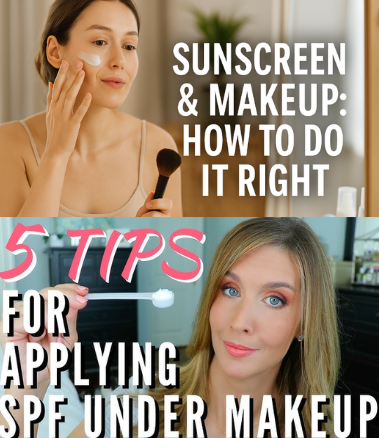
We all know sunscreen is non-negotiable if you want to keep your skin youthful and healthy. It’s your everyday armor against harmful UV rays, which are responsible for sunburn, premature wrinkles, dark spots, and even skin cancer. But when it comes to mixing sunscreen with makeup, things can feel complicated. Should it go before or after foundation? Can you rely on SPF in makeup? And how do you reapply without ruining your look? Let’s break it all down so you can protect your skin and still slay your makeup game.
Why Sunscreen Matters More Than You Think
SPF—or Sun Protection Factor—isn’t just a summer accessory. UV rays hit your skin 365 days a year, even on cloudy days, and even indoors through windows. This means sunscreen should be the very first step in your defense against aging. Dermatologists recommend SPF 30 or higher for daily wear. And here’s a crucial detail: make sure your sunscreen is free from harmful agents like oxybenzone and octyl methoxycinnamate (OMC). These chemicals not only irritate the skin but can disrupt hormones and harm aquatic ecosystems. A broad-spectrum sunscreen is your safest bet—it shields against both UVA (aging rays) and UVB (burning rays).
Choosing the Right Sunscreen for Your Face
Not all sunscreens are created equal. The wrong formula can leave your face greasy, cakey, or irritated, especially under makeup. Look for lightweight, non-comedogenic sunscreens designed specifically for the face. Gel-based or fluid sunscreens work beautifully as a base, doubling as a primer while giving your skin the protection it needs.
And no—your foundation or moisturizer with SPF isn’t enough. Most people don’t apply nearly enough product for the SPF level to be effective. To actually reach the stated SPF, you’d have to apply several layers of foundation, which nobody does. Treat makeup with SPF as a bonus, not your main line of defense.
The Correct Order: Sunscreen and Makeup Application
Wondering how sunscreen fits into your routine? Think of it as the invisible shield that goes directly on your skin. Here’s a simple step-by-step routine that ensures both protection and a flawless finish:
- Cleanse, tone, and moisturize your skin to create a smooth base.
- Apply sunscreen generously on your face, neck, and ears. Don’t skimp—about half a teaspoon is needed for full coverage.
- Allow it to absorb for a few minutes.
- Apply primer to lock everything in.
- Layer your foundation and other makeup products as usual.
- Finish with a setting spray to keep your look intact all day.
This order ensures that sunscreen forms the protective barrier it’s supposed to, while also helping your makeup last longer.
Video : How to apply suncream on your face
Chemical vs. Physical Sunscreens: Which Works Best with Makeup?
There are two main types of sunscreens, and how you apply them with makeup matters:
- Chemical sunscreen: These work by absorbing UV rays and converting them into heat. They need to be applied on bare skin, under makeup, and must be spread evenly to be effective. Once makeup is on, reapplying chemical sunscreen isn’t practical.
- Physical sunscreen: Made with zinc oxide or titanium dioxide, these act as a physical shield, reflecting UV rays. The good news? They often come in forms like powders or sprays, making them easier to reapply over makeup.
How to Reapply Sunscreen Over Makeup
Sunscreen protection fades after a few hours, especially if you’re outdoors. But reapplying doesn’t have to mean smudging your hard work. Here are some clever ways to do it:
- SPF Setting Powder: These lightweight powders double as makeup touch-ups while adding sun protection. Just sweep it on with a wide brush to mattify and protect at the same time.
- SPF Sprays or Mists: A refreshing way to reapply sunscreen without disturbing your foundation. A few spritzes throughout the day keep your shield strong.
- Compact Powder with SPF: Convenient for on-the-go touch-ups, compact powders help control shine while adding another layer of sun protection.
- Translucent Powder with SPF: Perfect if you don’t want to alter the color or texture of your makeup. It keeps everything in place while boosting protection.
Think of these methods as insurance—your morning sunscreen starts the job, and these midday reapplications keep it working strong.
Common Mistakes to Avoid
- Relying only on makeup SPF: It’s never enough. Always start with proper sunscreen.
- Applying too little sunscreen: A pea-sized drop won’t cut it—you need a generous layer for it to work.
- Skipping reapplication: Even the best sunscreen fades after a few hours, especially outdoors.
- Forgetting the neck and ears: These areas are just as exposed and just as vulnerable.
Bonus Tip: Sunscreen as a Makeup Base
When you pick the right sunscreen, it can actually improve your makeup routine. Many modern formulas smooth out the skin, minimize pores, and create a silky canvas for foundation. Instead of worrying about sunscreen ruining your makeup, think of it as the perfect primer that also protects.
Video : How to Reapply Sunscreen Over Makeup | Lab Muffin Beauty Science
Conclusion
Sunscreen and makeup don’t have to clash. With the right products and techniques, you can protect your skin from harmful UV rays while rocking a flawless face. Always apply sunscreen before your foundation, never rely solely on SPF-infused makeup, and make reapplication easy with powders or sprays. Remember—makeup enhances your beauty, but sunscreen preserves it. Protect first, glam up second, and your skin will thank you for years to come.


